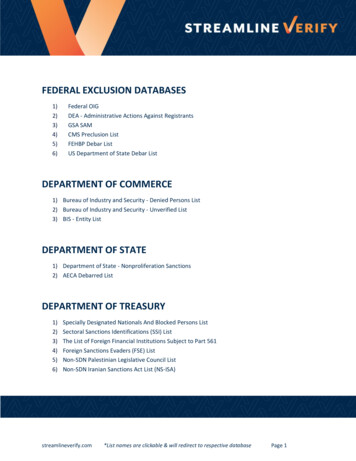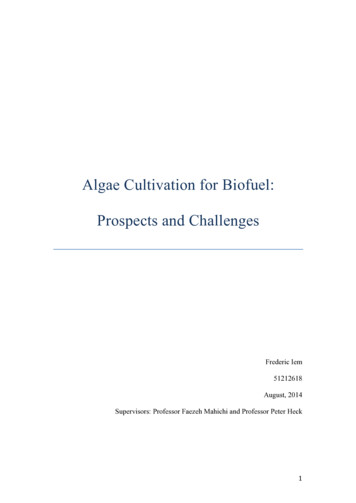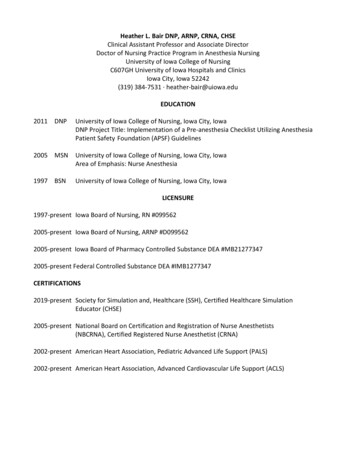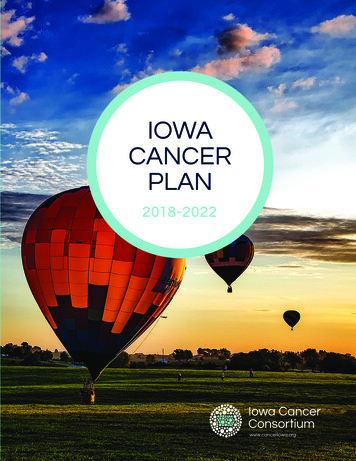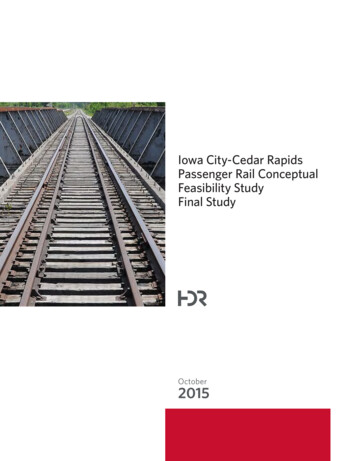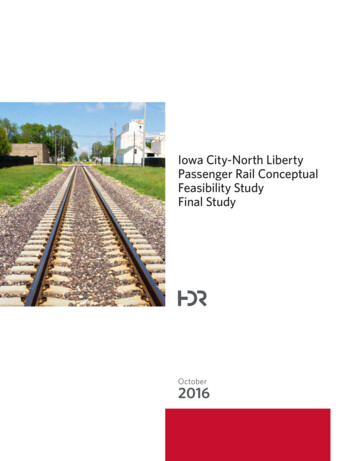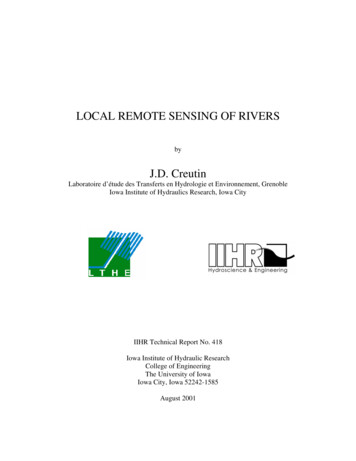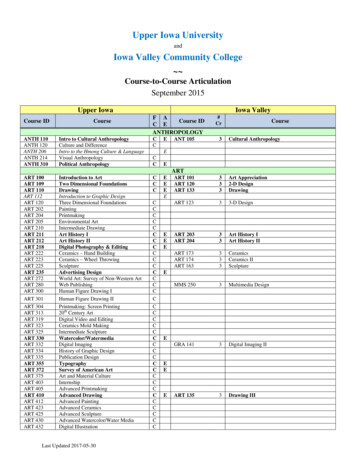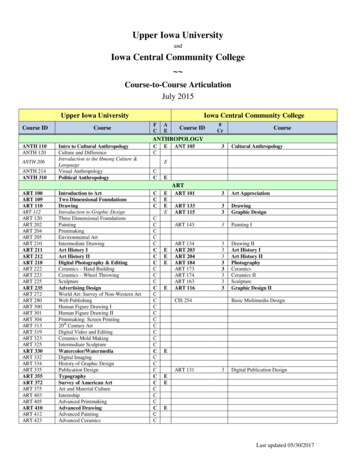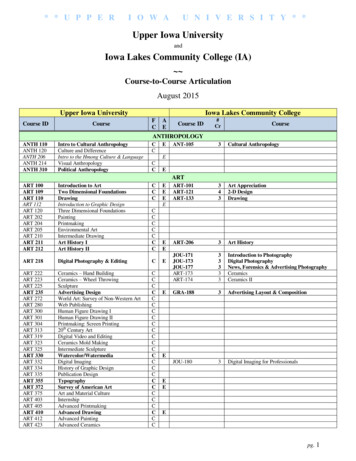
Transcription
Iowa’s Biofuel Retailers’ Tax CreditsTax Credits Program Evaluation StudyDecember 2019ByMandy JiaTax Research and Program Analysis SectionIowa Department of Revenue
PrefaceDuring the 2005 Legislative Session the Iowa Department of Revenue received anappropriation to establish the Tax Credits Tracking and Analysis Program to track taxcredit awards and claims. In addition, the Department was directed to assist thelegislature by performing periodic economic studies of tax credit programs. This is thethird economic study completed for these tax credits, with the first completed in 2009and the second evaluated exactly the same four tax credits in 2014.As part of the evaluation, an advisory panel was convened to provide input and adviceon the study’s scope and analysis. We wish to thank the members of the panel:Dawn Carlson(John Maynes)FuelIowaBiswa DasIowa State UniversityTim Johnson(Kevin Kuhle, Matt Steinfeldt)Iowa Farm BureauPaul OvromIowa Department of Agriculture andLand StewardshipMonte Shaw(Nathan Hohnstein)Iowa Renewable Fuels AssociationDoug StruykIowa Biodiesel BoardStephanie WeisenbachIowa Economic Development AuthorityThe assistance of an advisory panel implies no responsibility for the content andconclusions of the evaluation study.This study contains descriptions of some components of the four tax credits. Nothing inthis study should be construed as legal advice or guidance about claiming of the taxcredits. Summaries of the laws and regulations related to the tax credits discussed inthis study are not binding on the Iowa Department of Revenue, or the State of Iowa.This study and other evaluations of Iowa tax credits can be found on the Tax CreditsTracking and Analysis Program web page on the Iowa Department of Revenue website.1
Table of ContentsExecutive Summary . 7I. Introduction . 11II. Description of Iowa Biofuel Retailers’ Tax Credits . 12A. Ethanol Promotion Tax Credit . 13B. E85 Gasoline Promotion Tax Credit . 14C. E15 Plus Gasoline Promotion Tax Credit . 15D. Biodiesel Blended Fuel Tax Credit . 16III. Tax Credits, Incentives and Mandates for Biofuel Retailers Across the UnitedStates . 17A. Incentives for Retail Sales . 17A1. Tax Credits for Retail Sales. 17A2. Other Incentive Programs for Biofuel Sales . 18B. Incentives for Retailers’ Investments . 18B1. Tax Incentives for Retailers’ Investments . 18B2. Other Programs for Retailer Investments . 19C. Mandates or Explicit Goals . 19D. Other Major Iowa Programs Supporting Biofuel Sales . 20IV. Major Factors Affecting Ethanol and Biodiesel Sales . 22A. Infrastructure. 22B. Gasoline Pipeline Changes . 23C. Flex Fuel Vehicles . 24D. Alternative to Conventional Fuel Vehicles: Electric Vehicle Technology . 25E. Prices of Biofuels, Gasoline, and Diesel . 25V. Literature Review . 26A. Impacts of the Renewable Fuel Standard . 26B. Impact of the Federal Volumetric Ethanol Excise Tax Credit . 27C. Effectiveness of Oklahoma Ethanol Fuel Retailer Tax Credit . 28VI. Biofuel Retail Sales from Iowa Retailers Fuel Gallons Annual Reports . 28A. Biofuel Retail Sales 2007-2018. 28B. Retail Stations Selling Biofuel vs. Not Selling . 29VII. Claims of Iowa Retailers’ Tax Credits . 30A. Ethanol Promotion Tax Credit . 30B. E85 Gasoline Promotion Tax Credit . 31C. E15 Plus Gasoline Promotion Tax Credit . 31D. Biodiesel Blended Fuel Tax Credit . 322
VIII. Forecasts of Biofuel Retail Sales. 33A. Forecast of the Retailers’ Tax Credits Claims . 34B. Forecast of Statewide Biofuel Distribution Percentage . 34C. Estimated Revenue Gains if Lowering E15GC Summer Rate . 35IX. State of Iowa’s Spending on Biofuel Blending and Sales . 35X. Conclusion . 36References . 37Tables and Figures. 39Table 1. Ethanol Promotion Tax Credit Rate Schedule . 41Table 2. E85 Gasoline Promotion Tax Credit Rate Schedule . 42Table 3. E15 Plus Gasoline Promotion Tax Credit Rate Schedule . 42Table 4. Biodiesel Blended Fuel Tax Credit Rate Schedule . 43Table 5. Federal and State Comparison of Tax Credits for Biofuel Sales by Retailersor Blenders . 44Table 6. State Comparison of Other Incentive Programs for Biofuel Sales . 45Table 7. State Comparison of Tax Credits for Investments in Biofuel Infrastructure byRetailers . 48Table 8. Federal and State Comparison of Grants or Non-Tax Incentives forInvestments in Biofuel Infrastructure by Retailers . 49Table 9. Federal and State Biofuels Mandates or Goals and Other Investment orSales Incentive Programs . 51Table 10. Iowa Fuel Excise Tax Rates at Rack Level, 1989 – July 2020. 54Table 11. Iowa Sales of Ethanol and B11 Plus and Tax Reduction at Rack Level,Fiscal Years 2007 – 2019 . 54Table 12. Quarterly Iowa Biodiesel Production Sales Tax Refund, Calendar Years2012 – 2019 (2019 First Two Quarters Only) . 55Table 13. Iowa Renewable Fuel Infrastructure Grant Program Projects and Grants,Fiscal Years 2007 –2020 (Half Year) . 563
Table 14. Number of Flexible Fuel Vehicles (FFVs) Registered in Iowa, CalendarYears 2010 – 2019 . 57Table 15. Total Number of Flex Fuel Vehicles (FFVs) and E85 or E15-E20 Sales inIowa, Calendar Years 2009 – 2018 . 57Figure 1. Targeted and Actual Number of Flex Fuel Vehicles, Calendar Years 2009 –2019. 58Figure 2. Iowa Average Retail, Gasoline, E10 and E85 Prices per Gallon, CalendarYears 2011 – 2019 . 59Figure 3. Iowa Average Retail Diesel and B20 Prices per Gallon, Calendar Years2011 – 2019 . 60Table 16. Ethanol and Biodiesel Retail Sales, Calendar Years 2007 – 2018 . 61Table 17. Fuel Stations Average Sizes and Share in Urban Areas by Category,Calendar Year 2018. 62Table 18. Taxpayer Claims to Ethanol Promotion Tax Credit Reported on IA 148, TaxYears 2008 – 2017 . 63Table 19. Concentration of Ethanol Promotion Tax Credit Claims, Tax Years 2008 –2017. 64Table 20. Taxpayer Claims to E85 Gasoline Promotion Tax Credit Reported on IA148, Tax Years 2006 – 2017 . 65Table 21. Concentration of E85 Gasoline Promotion Tax Credits, Tax Years 2006 –2017. 66Table 22. Taxpayer Claims to E15 Plus Gasoline Promotion Tax Credit Reported onIA 148, Tax Years 2010 – 2017 . 67Table 23. Concentration of E15 Plus Gasoline Promotion Tax Credit, for Tax Years2011 – 2017 . 67Table 24. Taxpayer Claims to Biodiesel Blended Fuel Tax Credit Reported on IA 148,Tax Years 2006 – 2017 . 69Table 25. Concentration of Biodiesel Blended Fuel Tax Credits, Tax Years 2006 –2017. 70Table 26. Actual and Forecasted Biofuel Retailers’ Tax Credit Claims, Tax Years2006 – 2024 . 714
Table 27. Estimated Revenue Impacts If Summer E15GC Rate is Revised from 0.10to 0.03. 71Figure 4. Actual and Forecasted Biofuel Distribution Percentage, Calendar Years2007 – 2020 . 72Table 28. Actual and Estimated Resources of State of Iowa Dedicated to BiofuelRetail and Production, Fiscal Years 2007 – 2025 . 735
This page left blank intentionally.6
Executive SummaryVarious refundable tax credits were enacted in 2006 for Iowa biofuel retailers to help theState promote biofuel sales to meet the goal established by the Iowa General AssemblyHouse File (HF) 2754 that 25 percent of all petroleum used in gasoline in Iowa bereplaced by biofuels by 2020. Currently there are four tax credits provided for biofuelretailers in Iowa: the Ethanol Promotion Tax Credit, the E85 Gasoline Promotion TaxCredit, the E15 Plus Gasoline Promotion Tax Credit, and the Biodiesel Blended FuelTax Credit.Ethanol Promotion Tax Credit First available January 1, 2009, the Ethanol Promotion Tax Credit (EPTC) iscalculated using the pure amount of ethanol gallons sold by a retailer in Iowa andmultiplying those gallons by the tax credit rate. For example, 10 gallons of E10equals one gallon of pure ethanol. The tax credit is set to be repealed on January 1,2021. The EPTC rate earned by a retailer varies from 0.08 to 0.04. The tax credit rate isa function of the size of the retailer (whether sales exceed 200,000 gallons a year)and is determined by the difference between the biofuel threshold percentage andthe retailer’s biofuel distribution percentage. Biofuel distribution percentage iscalculated as the overall percentage of pure ethanol plus pure biodiesel gallons soldas compared to total gallons of gasoline (excluding any biodiesel or diesel gallonssold). The required biofuel threshold percentage steadily increases over the life ofthe tax credit from 6 percent for small retailers and 10 percent for large retailers, in2009, to 25 percent for all retailers in 2020.E85 Gasoline Promotion Tax Credit First available January 1, 2006, the E85 Gasoline Promotion Tax Credit (E85GC)provides a credit for each gallon of E85 sold by a retailer during the tax year. For taxyears 2012 through 2024, the tax credit rate is 0.16 per gallon. E85 requiresdedicated pumps and can only be used in flex fuel vehicles. The repeal date of thetax credit is January 1, 2025.E15 Plus Gasoline Promotion Tax Credit First available July 1, 2011, the E15 Plus Gasoline Promotion Tax Credit (E15GC) isavailable for retailers who sell blended gasoline with 15 to 69 percent ethanol, whichis classified as E15 Plus. Through 2013, the tax credit rate was 0.03 per gallon ofE15 sold during a year. For tax years 2014 through 2024, the tax credit rate is 0.03per eligible gallon sold throughout the year, except June 1 through September 15,when the rate is higher at 0.10 per gallon. Only vehicles model year 2001 or newer,or flex fuel vehicles, have been cleared by manufacturers to use E15 sold byretailers. The repeal date of the tax credit is January 1, 2025.7
Biodiesel Blended Fuel Tax Credit First available January 1, 2006, the Biodiesel Blended Fuel Tax Credit (BBFC) isavailable to retailers of biodiesel blended at 2 percent or higher. In calendar year2012, the tax credit rate was 0.02 per gallon for B2-B4 or 0.045 for B5 or higher.In calendar years 2013 through 2017, the tax credit equaled 0.045 per gallon for B5or higher; lower blends were no longer eligible. From 2018 to 2024, the credit equals 0.035 per gallon for B5-B10 and 0.055 for B11 or higher; blends lower than B5 areno longer eligible. The repeal date of the tax credit is January 1, 2025.Tax Credits, Mandates, and Incentives for Biofuel Retailers Across the UnitedStates Along with Iowa, four other states currently offer tax credits for retailers based on theamount of biofuels sold at retail stations. Twenty-two states including Iowa offer atax deduction or excise tax exemption for sales of biofuels. Five states currently offer tax credits for retailers based on investment made in theinfrastructure necessary to sell biofuels. Nine states (including Iowa) and the federalgovernment offer grants or non-tax incentives for investment in biofuel retailinfrastructure. The federal government mandates biofuel usage through the Renewable FuelsStandard (RFS). Some other states also have mandates or explicit goals for biofuelusage. In Iowa, besides the four tax credits discussed in this study, the State funds otherprograms to promote biofuel sales. The major programs include: excise tax ratereductions for ethanol or biodiesel at rack level, the Biodiesel Production Sales TaxRefund ( 0.02 per eligible biodiesel gallon), and the Renewal Fuel InfrastructureGrant Program.Other Major Determinants of Biofuel Sales The primary hurdle preventing fuel stations from adding higher ethanol blends isupgrading costs. Many existing retail facilities in Iowa will need significantinfrastructure upgrades to sell E15 or E85. Upgrading infrastructure incurs directcosts (primarily including equipment and materials, as well as labor costs ofremoving existing equipment and installing replacement equipment) and hiddencosts (such as revenue lost while shutting down the stations). Because of the largescope of work, the costs can be a significant investment for retailers.8
Gasoline pipeline changes can change the usage of ethanol. Starting September 15,2013, Iowa's largest pipeline operator, Magellan Midstream Partners, stoppedshipping regular 87-octane gasoline to its Iowa terminals. Instead, the pipelineoperator started shipping 84-octane gasoline, which cannot be legally sold in Iowabecause Iowa requires a minimum of 87-octane fuel be sold at gas pumps. Boostingthe fuel to the minimum octane requires either blending with ethanol or with moreexpensive 91-octane premium gasoline. This one-time pipeline change increasedethanol sales in Iowa around 2014. Flex fuel vehicles (FFV) are designed to run on gasoline or ethanol blends of up to85 percent. As of January 2019, there were 347,766 FFVs registered with the Stateof Iowa, which is short of the State target of 550,000 FFVs. Also, not all the FFVsare using E85. The popularity of electronic vehicles in the future could reduce the usage of bothgasoline and biofuels. In addition, prices of ethanol and biodiesel compared to gasoline and dieseldetermines the biofuel sales, since consumers are sensitive to prices.Ethanol and Biodiesel Sales in Iowa The Retailers Motor Fuel Gallons Annual Reports are completed by Iowa retailers toreport sales to consumers of gasoline, diesel, and biofuels each calendar year. Thereports allow the tracking of progress toward meeting the State goal of reaching abiofuel distribution percentage of 25 percent by 2020. According to 2007-2018 Retailers Motor Fuel Gallons Annual Reports, in general,the statewide biofuel distribution percentage was increasing, starting at 7.9 percentin 2007, rising to 9.1 percent in 2008, then increasing gradually in following years,reaching 13.4 percent in 2018 (where the increase to 11.4% in 2014 may reflect thepipeline change during that year). Using the same data, E15 or E20 sales started at 0.1 million gallons in 2011 andincreased quickly in recent years reaching 36.5 million gallons in 2018. E85 salesstarted at 4.2 million gallons in 2007 and increased to 20.2 million gallons in 2018. B1-B4 sales, in general, are decreasing, starting at 66.8 million gallons in 2007 andshrinking to 12.9 million gallons in 2018. B5-B10 sales generally increased from2007 to 2013, peaking at 181.6 million gallons in 2013, then decreased to 139.5million gallons in 2018. In general, sales of B11 or higher have been increasing(except for a few years), reaching over 300 million gallons in 2018.9
Biofuel Retailers’ Tax Credit Claims The number of EPTC claimants was 991 in tax year 2009, but declined each of thefollowing years, falling to less than 270 in tax year 2017, the most recent completetax year (see Table 18). The decline is likely due to retailers being unable to meetthe increasing biofuel threshold percentages. Total claims were 4.7 million in taxyear 2009. In tax year 2017, total claims had fallen to 0.7 million. In tax year 2006, the number of the E85GC claimants was 107. In tax year 2017 thenumber of claimants increased to 304 (see Table 20). The total claim amount startedat 0.5 million in 2006, reaching 2.5 million in tax year 2017. In tax year 2011, the number of E15GC claimants started at 28. Those claimantsclaimed over 18,252 in tax credits (see Table 22). The claim of this tax credit hasincreased rapidly. Numbers for tax year 2017, show 167 claimants for the E15GCexceeding 2.0 million in credits. In tax year 2006, the number of BBFC claimants was 76 (see Table 24). By 2017,the number of claims increased to 457 with claims totaling 19.2 million from 2.6million in 2006.The Future of Biofuel Retailers’ Tax Credits in Iowa Using data from the Retailers Motor Fuel Gallons Annual Report, future biofuel salesby retailers in Iowa were forecasted. In order to produce the forecasts, a variety ofassumptions about the growth of Iowa fuel sales are applied, including aggregateannual sales growth rates by type of fuel and growth in the number of stations sellingbiofuels. EPTC claims are expected to experience a continued decrease dropping to anestimated 0.9 million in 2020 as fewer retailers qualify over time. E85GC claims areestimated to increase from 2.0 million in 2017 to an estimated 4.5 million in 2024due to the steady tax credit rate and continued growth in sales. E15GC claims areforecasted to increase from 2 million in 2017 to an estimated 5.7 million in 2024.The claim amount for BBFC is estimated to increase to 16.4 million in 2017 andrise steadily to an estimated 23.5 million in 2024. The statewide biofuel distribution percentage, 13.4 percent in 2018, is forecasted tocontinue increasing moderately, rising to 14.7 percent in 2024. This estimatedpercentage will be significantly lower than the goal of HF 2754, which had the Statereplacing 25 percent of sold gasoline with biofuels.10
I. IntroductionIn the Unites States, various public policies are aimed at increasing biofuel consumptionand reducing crude oil consumption for energy independence and reducing carbonemissions. Among these policies, some tax incentive programs are created with thepurpose of raising biofuel sales for biofuel retailers, who provide fuels to finalconsumers in the fuel market.In 2006, the Iowa General Assembly enacted HF 2754, an act pertaining to thepromotion of biofuels usage. The act provided incentives for the installation of biofuelsinfrastructure and the promotion of biofuel sales, including three biofuel retailers’ taxcredits. The incentives were included to assist in meeting the legislation’s goal that 25percent of all petroleum used in the formulation of gasoline consumed in the state bereplaced by biofuels by the year 2020. In Iowa, there are currently four tax creditsprovided for biofuel retailers: the Ethanol Promotion Tax Credit (EPTC), the E85Gasoline Promotion Tax Credit (E85GC), the E15 Plus Gasoline Promotion Tax Credit(E15GC), and the Biodiesel Blended Fuel Tax Credit (BBFC).This study analyzes the claims of these tax credits using historical data from tax years2006 through 2017 (with 2017 being an incomplete tax year). During this period, theU.S. economy has been in a positive phase of the economic cycle. As a result,economic expansion can be one factor (among other factors) that drives the growth inbiofuel sales during these years. The objective of this study is to examine the patternsof claimants and the claims of these four tax credits, and evaluate the effectiveness ofthese tax credits compared to the possibility for the state achieving the goal establishedin HF 2754 based on biofuel sales forecasts.Since the passage of HF 2754, the Iowa Department of Revenue (IDR) has completedtwo evaluation studies on the related tax credits. In 2009, the first evaluation study ofIowa’s four biofuel retailers’ tax credits effective in tax years 2002 through 2009, whichincluded the Ethanol Blended Gasoline Tax Credit (EBGC) (enacted for tax years 2002through 2008), the E85GC, and the BBFC. The 2009 evaluation study included claiminformation through tax year 2007. The 2009 study also presented information on thenewly enacted the EPTC which was first available in tax year 2009. The 2014evaluation study evaluated the same four tax credits as this study for claims made in taxyears through 2012.Section II of this report provides a description of each of the tax. Section III providesinformation about tax incentives and similar tax credits in other states and at the federallevel. Section IV provides an overview of the major factors affecting ethanol andbiodiesel sales. Section V presents a literature review of the impacts of biofuelmandates or tax credits. Section VI reviews biofuel retail sales from Iowa Retailers FuelGallons Annual Reports. Section VII presents the claims of the Iowa biofuel retailers’ taxcredits while Section VIII provides forecasts of Iowa biofuel sales. Section IX willdiscuss Iowa’s spending on biofuel blending and sales. The final section of this reportprovides a brief conclusion.11
II. Description of Iowa Biofuel Retailers’ Tax CreditsRetailers selling biofuels out of fuel pumps in Iowa are eligible to claim any of the fourretailers’ tax credits, including the Ethanol Promotion Tax Credit, the E85 GasolinePromotion Tax Credit, the E15 Plus Gasoline Promotion Tax Credit, and the BiodieselBlended Fuel Tax Credit, for which they qualify. The purpose of these tax credits is toprovide tax incentives to fuel retailers for selling renewable biofuels to help achieve thegoal that by January 1, 2020, biofuels will replace 25 percent of petroleum used in theformulation of gasoline consumed in Iowa.1 Retailers in this study refer to retail dealersof gasoline who operate fuel pumps at an Iowa retail fuel site, where tank wagons areconsidered retail fuel sitesThe four tax credits offered to biofuel retailers have common characteristics as follows: The tax credits are automatic and do not require an award. This means that anyretailer who meets the sales requirement is eligible to make a claim. The tax credits are refundable. While a nonrefundable tax credit can only reducea taxpayer’s tax liability to zero, a refundable tax credit allows the taxpayer toreceive a refund from the State when the tax credit claim amount exceeds taxliability. Instead of a refund, the taxpayer may choose to carry forward credit tothe next tax year. The tax credits are not transferable.The tax credits can be claimed against Iowa individual income tax (including fiduciaries)or corporation income tax. Businesses that are organized as partnerships, Scorporations, limited liability companies (LLC), estates, or trusts must allocate the prorata share of any earned tax credits to the individual members of the entity. In thesecases, the claims would be made against individual income tax with a reference to thepass-through entity who has earned the tax credit. These claimants are referred to as“pass-through taxpayers.”Under current law there are some overlaps between these tax credits. For the same taxyear for the same ethanol gallons sold, a retailer can claim both the EPTC and E15GCfor E15 sales, or both EPTC and E85GC for E85 sales if they meet the requirements ofeach of these tax credits.The IA 148 Tax Credits Schedule must be filed with the tax return on which any of thefour tax credits are claimed. In addition to the IA 148, taxpayers must also include FormIA 137 to claim the EPTC, Form IA 135 to claim the E85GC, Form IA 138 is required toclaim the E15GC, and the IA 8864 is required to claim the BBFC.The goal in HF 2754 is stated as “It is the goal of this state that by January 1, 2020, all biofuel willreplace twenty-five percent of all petroleum used in the formulation of gasoline.” "Biofuel" is defined asethanol or biodiesel.112
A. Ethanol Promotion Tax CreditEthanol is a renewable, produced alcohol fuel made from plant material, such as corn,sugar cane, or grasses. Using ethanol can reduce oil dependence and greenhouse gas(GHG) emissions. A new U.S. Department of Agriculture (USDA) study, byLewandrowski et. al. (released March 25, 2019), finds greenhouse gas emissions fromcorn-based ethanol are 39-43 percent lower than gasoline. According to the EnergyInformation Administration (EIA), the energy content of ethanol is about 33 percent lessthan pure gasoline. Most of the gasoline now sold in the United States contains 10percent ethanol (E10).The Ethanol Promotion Tax Credit was created to replace the Ethanol Blended GasolineTax Credit, which expired December 31, 2008. Beginning January 1, 2009, motor fuelretailers selling ethanol blended gasoline, including E10, E85, and E15, may be eligibleto claim the EPTC. The tax credit is set to be repealed on January 1, 2021.The amount of the EPTC tax credit is calculated using the pure amount of ethanolgallons sold by a retailer in Iowa. For example, 10 gallons of E10 equals one gallon ofpure ethanol. The tax credit rate of the EPTC earned by a retailer depends on the sizeof the retailer and the difference between the applicable biofuel threshold percentageand the retailer’s biofuel distribution percentage. The retailer’s biofuel distributionpercentage is calculated as the ratio of pure ethanol gallons plus pure biodiesel gallonsto total gasoline gallons sold (excluding any biodiesel or diesel gallons sold).For retailers selling more than 200,000 gallons per year at all retail locations (largeretailers), the applicable biofuel threshold percentage was 10 percent in calendar year2009, increasing one percentage point each year reaching 15 percent in calendar year2014, then increasing two percentage points each year until it reaches 25 percent incalendar year 2019 and after (see Table 1).The applicable biofuel threshold percentage for retail dealers selling no more than200,000 gallons per year (small retailers) was 6 percent in calendar years 2009 and2010 and 10 percent in 2011. The
First available January 1, 2009, the Ethanol Promotion Tax Credit (EPTC) is calculated using the pure amount of ethanol gallons sold by a retailer in Iowa and multiplying those gallons by the tax credit rate. For example, 10 gallons of E10 equals one gallon of pure ethanol.
